Part three of four of the series “The Crisis in Civil Rights: Recommended Readings on Race, Police, and the Welfare State.”
If you can read just one item on this list, then make it “The Great Society as Political Strategy,” by Frances Fox-Piven, reprinted in The Politics of Turmoil: Poverty, Race, and the Urban Crisis. If you can read only two, make your second choice Losing Ground: American Social Policy, 1950-1980, by Charles Murray.
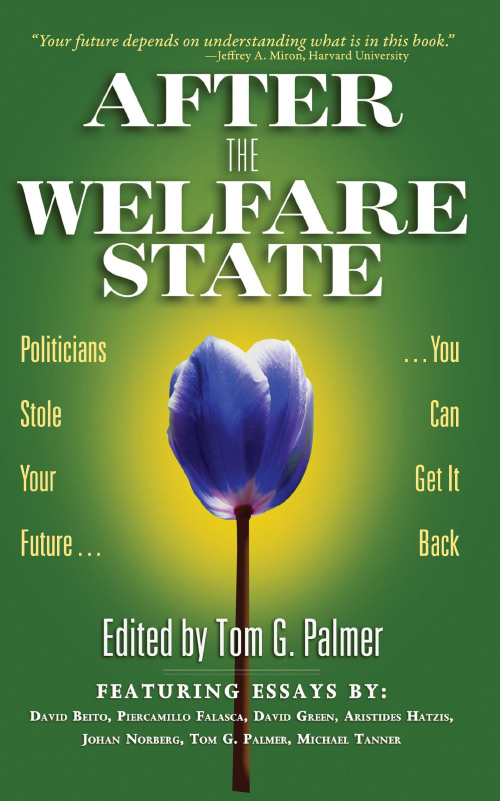 After the Welfare State: Politicians Stole Your Future, You Can Get It Back, ed. by Tom G. Palmer. Jameson Books, 2012.
After the Welfare State: Politicians Stole Your Future, You Can Get It Back, ed. by Tom G. Palmer. Jameson Books, 2012.
An overview of the unsustainability and unintended consequences of the welfare state. Donald J. Boudreaux wrote, “After the Welfare State makes serious economic analysis of current events readable, enlightening, and enjoyable. Spending other people's money—even with the best of intentions—is a recipe for conflict and even catastrophe, as the authors demonstrate in one country after another.”
“The ‘Crowding-Out’ Effect of Governmental Transfers on Private Charitable Contributions,” by Burton A. Abrams and Mark D. Schitz. Public Choice, vol. 33 (1978), pp. 29–39.
From the concluding remarks of the article: “The [analysis] provides support for the proposition that governmental social-welfare transfers have actually served to attenuate private charitable giving.”
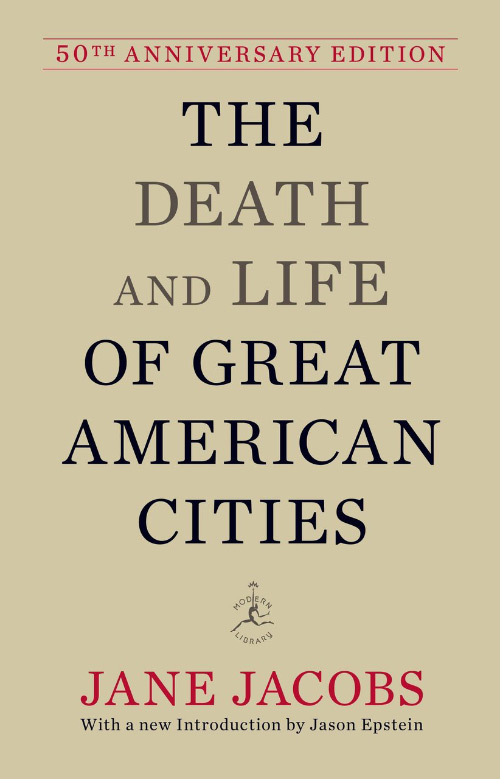 The Death and Life of Great American Cities, by Jane Jacobs. Vintage, 1992.
The Death and Life of Great American Cities, by Jane Jacobs. Vintage, 1992.
John Weicher writes, “Although it was not her intention, Jane Jacobs has gone far toward providing conservatives with an urban program. Her book . . . is permeated with conservative and free-market attitudes. . . . [S]he castigates the planners of housing-project Utopias that leave no room for their inhabitants to make any plans of their own. . . . Mrs. Jacobs says, . . . ‘City processes in real life are too complex to be routine, too particularized for application as abstractions. They are changes made up of interaction among unique combinations of particulars.’”
 The Economics of Charity: Essays in the Comparative Economics and Ethics of Giving and Selling, With Applications to Blood, by Armen A. Alchian et al. Institute of Economic Affairs, 1973.
The Economics of Charity: Essays in the Comparative Economics and Ethics of Giving and Selling, With Applications to Blood, by Armen A. Alchian et al. Institute of Economic Affairs, 1973.
Alchian et al. give their take on the economics of giving, with attention paid to a unique quandary in the field of economics of charity—“Will the supply of blood donations meet the demand?”
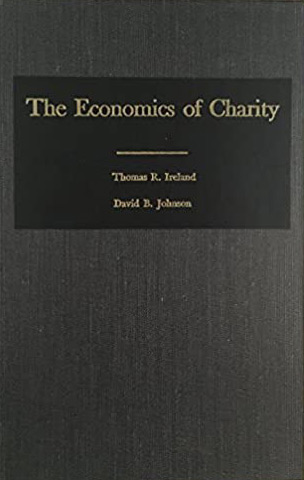 The Economics of Charity: Part 1 and Part II, by Thomas R. Ireland and David B. Johnson. Center for the Study of Public Choice, 1970.
The Economics of Charity: Part 1 and Part II, by Thomas R. Ireland and David B. Johnson. Center for the Study of Public Choice, 1970.
An introduction to the economics of charity, told in two parts with juxtaposing views. The Department of the Treasury’s Commission on Private Philanthropy and Public Needs summarized the book well, writing, “The Ireland piece includes an extended discussion of the ‘Kantian’ motive for giving, among others. It contends with budgeting in a united fund-raising organization. Johnson presents a summary of utility interdependence and argues the importance of social pressure as a determinant of giving.”
 “The End of Welfare and the Contradiction of Compassion,” by Stephen T. Ziliak. The Independent Review, vol. 1, no. 1 (Spring 1996), pp. 55–73. Download PDF
“The End of Welfare and the Contradiction of Compassion,” by Stephen T. Ziliak. The Independent Review, vol. 1, no. 1 (Spring 1996), pp. 55–73. Download PDF
The Independent Institute’s synopsis reads, “When welfare (then called ‘public outdoor relief’) was abolished in large- and medium-size cities of the United States more than a century ago, private charities stepped in, spending just as much on aid as the cities had spent. If welfare dependency occurred under public assistance, it continued even after private charity took over, with aid recipients spending just as much time on the private dole as they had on public assistance.”
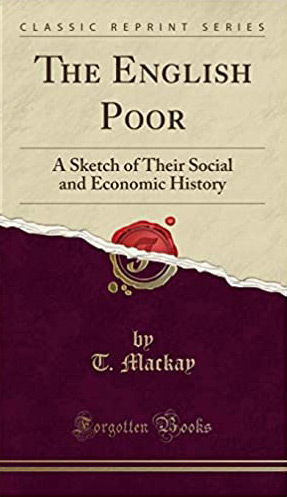 The English Poor, A Sketch of Their Social and Economic History, by Thomas Mackay. Spalding Press, 2010.
The English Poor, A Sketch of Their Social and Economic History, by Thomas Mackay. Spalding Press, 2010.
Mackay was concerned about the harmful effect of outdoor poor-relief programs on the character of recipients, and he wanted to restore personal independence and reduce “the encouragement to pauperism.” By pauperism, he meant long-term dependence on relief payments.
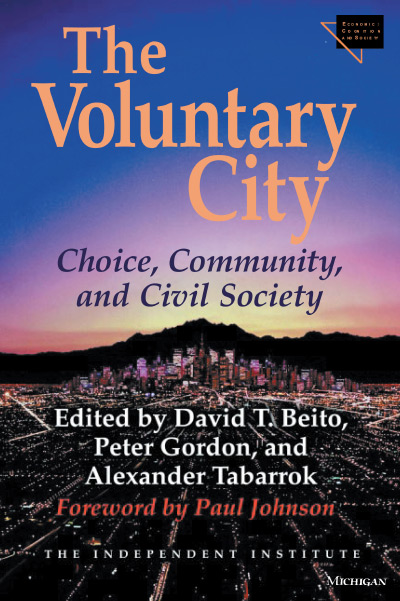 “‘This Enormous Army’: The Mutual Aid Tradition of American Fraternal Societies Before the Twentieth Century,” by David T. Beito, chapter 8 from The Voluntary City: Choice, Community, and Civil Society, edited by David T. Beito, Peter Gordon, and Alexander Tabarrok, foreword by Paul B. Johnson. University of Michigan Press for the Independent Institute, 2002.
“‘This Enormous Army’: The Mutual Aid Tradition of American Fraternal Societies Before the Twentieth Century,” by David T. Beito, chapter 8 from The Voluntary City: Choice, Community, and Civil Society, edited by David T. Beito, Peter Gordon, and Alexander Tabarrok, foreword by Paul B. Johnson. University of Michigan Press for the Independent Institute, 2002.
A history of how American fraternal societies assisted the poor in getting off dependence on relief.
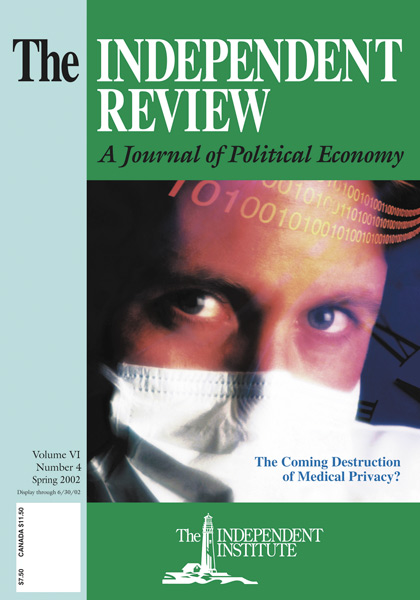 “Review of Fighting Poverty with Virtue: Moral Reform and America’s Urban Poor, 1825-2000, by Joel Schwartz” reviewed by Stephen T. Ziliak. The Independent Review, vol. 6, no. 4 (Spring 2002), pp. 618–622.
“Review of Fighting Poverty with Virtue: Moral Reform and America’s Urban Poor, 1825-2000, by Joel Schwartz” reviewed by Stephen T. Ziliak. The Independent Review, vol. 6, no. 4 (Spring 2002), pp. 618–622.
In his book Fighting Poverty with Virtue Moral Reform and America’s Urban Poor, 1825-2000, Joel Schwartz focuses on the efforts of several social reformers, who preached industrial virtues. In doing so, Schwartz seeks to draw a parallel with today’s “efforts to remoralize the poor.” For Schwartz, social reformers who dealt with the issue of poverty in the nineteenth century were, “more distressed by dependence occasioned by vice than by the simple fact of material deprivation.” In his review of Schwartz’s book, Ziliak is skeptical of some of Schwartz’s ideas, pointing out that several prerequisites (such as the relativistic conceptions of the “poverty line”) must be addressed prior to a substantive cultural change with respect to poverty.
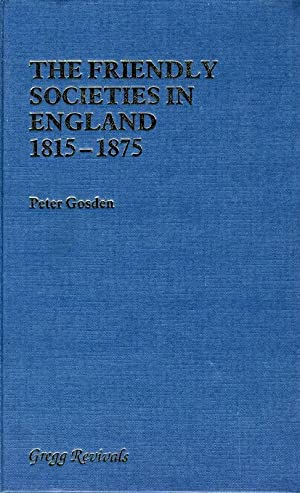 The Friendly Societies in England, 1815-1875, by P. H. J. H. Gosden. Manchester Press, 1961.
The Friendly Societies in England, 1815-1875, by P. H. J. H. Gosden. Manchester Press, 1961.
Bernard Semmel’s review reads, “[Gosden’s work] is a useful discussion of the structure of nineteenth-century English friendly societies. The friendly society, rooted in the medieval guild, became the most characteristic working-class institution of England’s ‘golden age,’ and by 1870 friendly societies had nearly four times the membership of the trade unions and the cooperative societies combined. . . . [Friendly society membership] was drawn from a variety of trades, and its assets were scrupulously disbursed for the traditional purposes of providing sick and old-age payments, burial expenses, and survivors’ benefits.”
 From Mutual Aid to the Welfare State: Fraternal Societies and Social Services, 1890-1967, by David T. Beito. University of North Carolina Press, 2000.
From Mutual Aid to the Welfare State: Fraternal Societies and Social Services, 1890-1967, by David T. Beito. University of North Carolina Press, 2000.
Beito details how voluntary fraternal societies and other mutual support groups took care of the poor and less fortunate, before being crowded out by welfare programs in the 1960s.
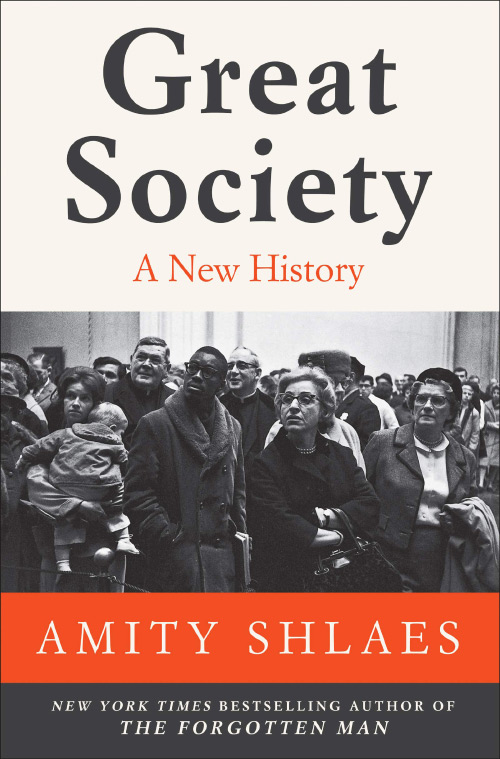 Great Society: A New History, by Amity Shlaes. Harper Collins, 2019.
Great Society: A New History, by Amity Shlaes. Harper Collins, 2019.
The compelling history of the characters and personalities behind mid-twentieth-century political reforms. The Wall Street Journal review reads, “An illuminating alternative to sentimental reminiscences of liberals’ attempts in the 1960s . . . to banish poverty in America. Her account is original and persuasive, presenting the leading poverty warriors not with scorn but with sympathy and piercing insight. . . . Ms. Shlaes’s chronicle is not just a story of how good people’s good intentions went wrong. It is also a story of how the assumption that the near future will closely resemble the recent past can lead even the best intentioned and most well-informed people to pursue policies that turn out to be mostly counterproductive and often destructive.”
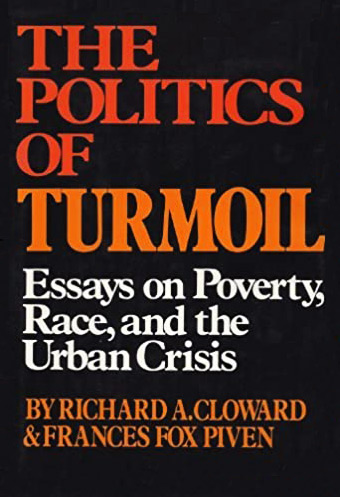 “The Great Society as Political Strategy,” by Frances Fox-Piven. Columbia Forum, Summer 1970. Reprinted in The Politics of Turmoil: Poverty, Race, and the Urban Crisis, by Richard Cloward and Frances Piven. Vintage Books, 1975, pp. 271–283.
“The Great Society as Political Strategy,” by Frances Fox-Piven. Columbia Forum, Summer 1970. Reprinted in The Politics of Turmoil: Poverty, Race, and the Urban Crisis, by Richard Cloward and Frances Piven. Vintage Books, 1975, pp. 271–283.
Tom G. Palmer writes about Piven’s essay, “The Great Society put federal money directly into urban neighborhoods, bypassing state and city administrations that were at the time dominated by either southern racist white Democrats, white ethnic coalitions (people of recent Polish, Italian, Irish, or other European extraction) or (even worse from the perspective of Democratic strategists) Republicans. Had the funds gone through Democratic machines dominated by old southern Democrats, urban white ethnics, or Republicans, they would not have reached the urban African American voters whom the national Democrats were targeting. The goal was to make those voters increasingly dependent on, and thus loyal to, the national Democratic Party.”
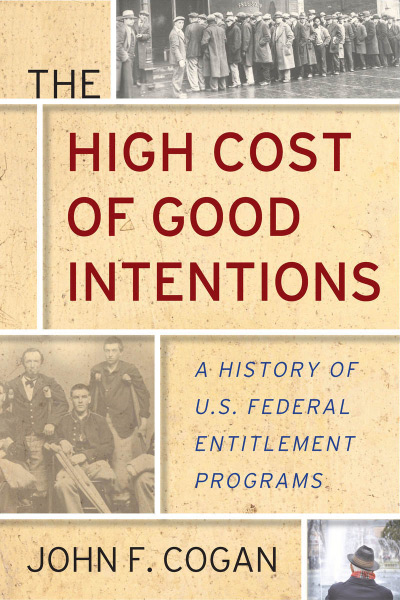 The High Cost of Good Intentions: A History of U.S. Federal Entitlement Programs, by John F. Cogan. Stanford University Press, 2017.
The High Cost of Good Intentions: A History of U.S. Federal Entitlement Programs, by John F. Cogan. Stanford University Press, 2017.
Cogan writes, “The book’s central theme is that the creation of entitlements brings forth relentless forces that cause them to inexorably expand. These liberalizing forces are inevitable and inseparable from the entitlements themselves. They originate from a well-meaning human impulse to treat all similarly situated people equally under the law. When first enacted, entitlement laws, for policy or fiscal reasons, confine benefits to a group of individuals who are deemed to be particularly worthy of assistance. As time passes, groups of excluded individuals come forth claiming that they are no less deserving of aid. Pressure is brought by, or on behalf of, excluded groups to relax eligibility rules. The ever-present pressure is magnified during periods of budget surpluses and by public officials’ imperative to be elected and reelected. Eventually the government acquiesces and additional claimants deemed worthy are allowed to join the benefit rolls. That very broadening of eligibility rules inevitably brings another group of claimants closer to the eligibility boundary line, and the pressure to relax qualifying rules begins again. The process of liberalization repeats itself until benefits are extended to a point where the program’s purposes bear only a faint resemblance to its original noble intentions.”
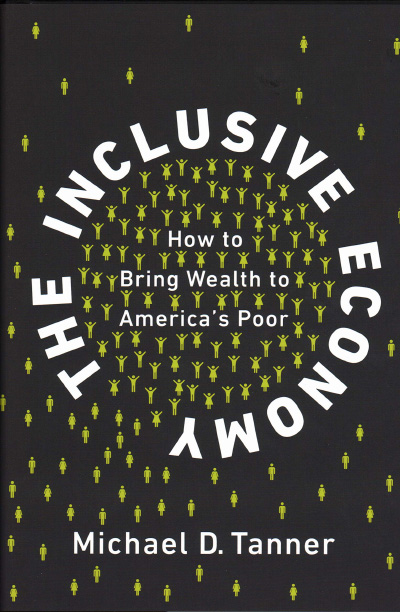 The Inclusive Economy: How to Bring Wealth to America’s Poor, by Michael D. Tanner. Cato Institute, 2018.
The Inclusive Economy: How to Bring Wealth to America’s Poor, by Michael D. Tanner. Cato Institute, 2018.
How welfare programs ignore the problems facing America’s poor and what to do about it. Tanner writes, “As this book will show, government has generally made matters worse, both culturally and structurally. Almost every government intervention to help the poor has had unintended consequences that have actually trapped millions of Americans in poverty. Some of these interventions were malign; others were well intentioned. But nearly all hurt far more than they helped.”
 Is the Welfare State Justified?, by Danny Shapiro. Cambridge University Press, 2007.
Is the Welfare State Justified?, by Danny Shapiro. Cambridge University Press, 2007.
Shapiro’s work of political theory challenges the philosophical premise of the current setup of the American welfare state. Jeffrey Friedman writes, “This is a marvelous, unusual book. It’s one of the few attempts in political philosophy that go beyond examining what principles of justice require, by investigating whether contemporary institutions designed to produce those outcomes actually do better than realistic alternatives. I suspect it will have a large audience not only among normative political theorists, who will find stimulating its challenges to welfare state institutions they have taken for granted, but among policy analysts and public-administration specialists with a reflective bent. It’s a fresh and welcome approach to political theory that could prompt a long-overdue movement to bring theory out of the clouds.”
“Justice, ‘Needs,’ and Charity,” by Robert L. Cunningham. New Individualist Review, vol. 4, no.1 (Summer 1965), pp. 720–727. Download PDF
Cunningham writes, “Why not, however, broaden the designation of ‘just’ to include much of what was hitherto included under ‘charitable’? If government will now promote charity, mercy, love—why not? For a very simple reason, indeed: because government has no goods of its own to distribute in charity and mercy. What goods it has it obtained from others who were (implicitly) threatened with violence if they did not pay what they ‘owe.’ There is all the difference in the world between helping the poor by a free gift, and being ready to take away from the rich what he would otherwise unjustly—by the criteria of social justice—retain and then giving this to the poor.”
“Lodge Doctors and the Poor: Organized Medicine Destroyed the Vibrant Health-Care Alternative of Lodge Practice,” by David T. Beito. The Freeman, May 1994, pp. 220-225.
In the early years of the 1900s, fraternal societies popularized "lodge practice" whereby the societies retained the services of a physician as a benefit of fraternal membership, with other types of private organizations following suit. Beito writes that, "Before the rise of the welfare state, [fraternal societies] were rivaled only by churches as organizational providers of social welfare. By conservative estimates eighteen million American men and women were members in 1920 at least three out of every ten adult males." Such a service was invaluable to the working poor, though the practice experienced an unfortunate demise at the hands of special interests.
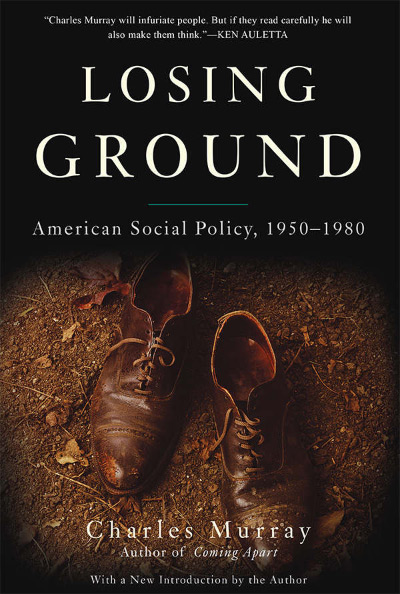 Losing Ground: American Social Policy, 1950-1980, by Charles Murray. Basic Books, 2015.
Losing Ground: American Social Policy, 1950-1980, by Charles Murray. Basic Books, 2015.
In the words of David Frum: “This book [is] in many ways . . . a work of imagination. It relies on what he calls his ‘thought experiments,’ where he invites you to look at problems from very different angles and other people’s points of view. He suggests thoughts in your head that you can’t prove exactly but seem persuasive when he shows them to you. What he tried to show was that the intensification of welfare dependency was not a result of the economy malfunctioning and that, paradoxically, the solution to the problems of the extremes and very ugly forms of poverty that were becoming visible was not greater support from government but less. These were ideas that had been germinating in conservative minds in one way or another—George Gilder’s Wealth of Poverty, published in 1981, had some early sketches of some of these ideas. But Murray really sealed the case. This is the book that was the intellectual antecedent of the welfare reform of the middle 1990s that now most people regard as one of the great successes of American public policy.”
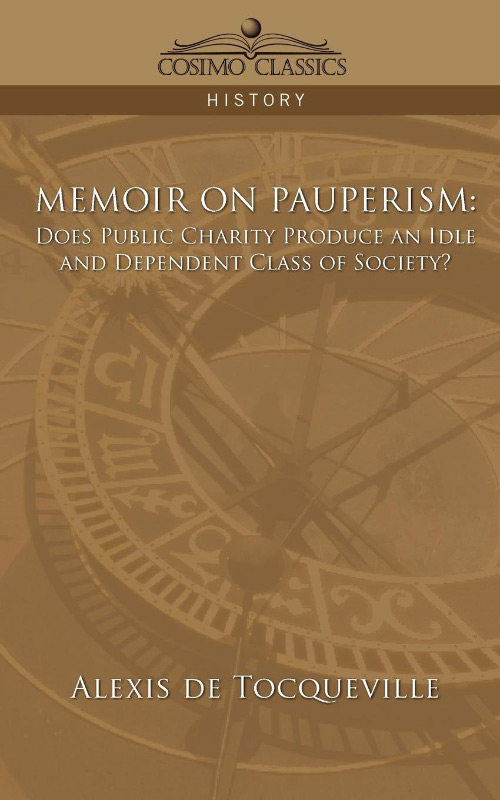 Memoir on Pauperism, by Alexis de Tocqueville. Translated by Seymour Drescher, with an Introduction by Gertrude Himmelfarb. Civitas, 1997. Download PDF
Memoir on Pauperism, by Alexis de Tocqueville. Translated by Seymour Drescher, with an Introduction by Gertrude Himmelfarb. Civitas, 1997. Download PDF
Max Hartwell writes, “The article advanced a widely-held and long-standing theory, still debated by today’s historians, about the effects of the Poor Laws on the English economy. It argued that the effect of public charity was to foster an anti-work mentality and to produce a demoralised and dependent working class.
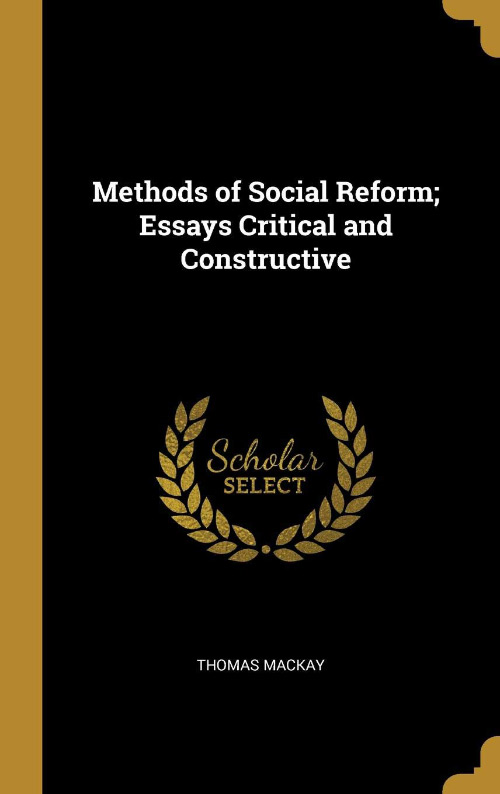 Methods of Social Reform: Essays Critical and Constructive, by Thomas Mackay. John Murray, 1896. Read on Google Play
Methods of Social Reform: Essays Critical and Constructive, by Thomas Mackay. John Murray, 1896. Read on Google Play
How labor union job monopolies, poor relief measures, and boondoggle public spending block the economic mobility of the poor. Mackay said that true welfare reform would only be “a re-creation and development of the arts of independence.” He called “not for more philanthropy, but rather for more respect for the dignity of human life, and more faith in its ability to work out its own salvation.” Mackay said that “the bitterest element in the distress of the poor arises, not from mere poverty, but from the feeling of dependence which must of necessity be an ingredient in every measure of public relief. This feeling cannot be removed, but is rather intensified by liberal measures of public relief.”
Morals and the Welfare State, by F. A. Harper. Foundation of Economic Education, 1951.
Harper offers a series of five moral postulates and ethical precepts, showing that the American welfare system lacks proper justification. He writes, “What are usually advertised, instead, are the ‘benefits’ of the Welfare State—the grants of food and housing and whatnot—which the state ‘gives’ to the people. But all these ‘benefits’ are merely the other side of the forfeited rights to choose one’s own occupation and to keep whatever one is able to produce.”
“Mutual Aid for Social Welfare: The Case of American Fraternal Societies,” by David T. Beito. Critical Review, vol. 4, no. 4 (Fall 1990), pp. 709-736.
From the abstract: “With the possible exception of churches, fraternal societies were the leading providers of social welfare in the United States before the Great Depression. Their membership reached an estimated 50 percent of the adult male population and they were especially strong among immigrants and African Americans. Unlike the adversarial relationships engendered by governmental welfare programs and private charity, fraternal social welfare rested on a foundation of reciprocity between donor and recipient. By the 1920s, fraternal societies and other mutual aid institutions had entered a period of decline from which they never recovered. The many possible reasons for this decline included the rise of the welfare state, restrictive state insurance regulation, and competition from private insurers.”
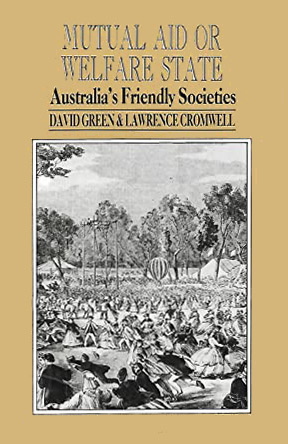 Mutual Aid or Welfare State: Australia’s Friendly Societies, by David G. Green and Lawrence Cromwell. Allen & Unwin, 1984.
Mutual Aid or Welfare State: Australia’s Friendly Societies, by David G. Green and Lawrence Cromwell. Allen & Unwin, 1984.
How Australia’s friendly societies successfully provided mutual health funds, medical care, and loan assistance for those in need before being crowded out by nationalized health care.
The New Consensus on Family and Welfare: A Community of Self-Reliance. American Enterprise Institute, 1987.
AEI’s synopsis reads, “This book offers the consensus of a philosophically diverse group of scholars and former government administrators on how to reduce welfare dependency. The Working Seminar bases its conclusions on statistical data on income, education, participation in the labor force, welfare benefits, marital status, and birth rates. Their findings describe a new form of poverty—behavioral dependency—caused not by low income alone, but by a growing inability to cope.”
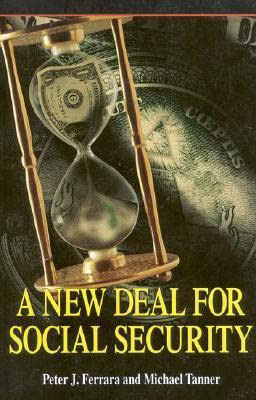 A New Deal for Social Security, by Peter Ferrara and Michael D. Tanner. Cato Institute, 1998.
A New Deal for Social Security, by Peter Ferrara and Michael D. Tanner. Cato Institute, 1998.
Authors Ferrara and Tanner cover the origins and ills of the Social Security system and offer alternative models for old-age pensions.
A New Way to Care: Social Protections that Put Families First, by John C. Goodman. Independent Institute, forthcoming 2020.
Publisher’s publicity material: “Too many government safety-net programs are riddled with disincentives that discourage families from doing what would be in everyone’s best interests. They penalize people who go back to work. . . . And these programs make access to healthcare—for those who’ve recently lost coverage—contingent on income and assets in unfair and arbitrary ways. Perverse incentives also help explain why disability claims have soared in recent decades for Social Security Disability Insurance, Supplemental Security Income, disability benefits for veterans, and state-based Worker’s Compensation. To become a true public-policy innovator, America must also take additional bold steps.”
As New Way to Care shows, families would have their needs better met if they were allowed to opt out of rigid, inefficient, and counterproductive government programs and to enroll in alternatives that offered greater choice and flexibility. The sign on the path to the promised land, however, need not say “Take It or Leave It.” Allowing individuals to opt out partially and progressively over time would reduce people’s concerns and make Goodman’s win-win strategy even more politically attractive.”
 “Review of Overcoming Welfare: Expecting More from the Poor and from Ourselves, by James L. Payne,” by Stephen T. Ziliak. The Independent Review, vol. 4, no. 1 (Summer 1999), pp. 144–147.
“Review of Overcoming Welfare: Expecting More from the Poor and from Ourselves, by James L. Payne,” by Stephen T. Ziliak. The Independent Review, vol. 4, no. 1 (Summer 1999), pp. 144–147.
A review of James L. Payne’s book Overcoming Welfare, in which Payne argues that America should “overcome welfare” in pursuit of moral virtue. Ziliak writes, “That America has a miserable record after four hundred years of public assistance is hardly the lament of conservatives alone; the idea has broad support among scholars in the field, from Frances Fox Piven to Gertrude Himmelfarb. Payne’s optimistic vision is old but admirable. He wants to replace welfare with a more economically productive, democratically participatory, flexible, voluntaristic, and spiritually uplifting alternative. He suggests that the alternative is exemplified in America’s past, in the Charity Organization Movement of the late nineteenth century. Unfortunately, however, Payne’s scholarship on that period betrays his vision.”
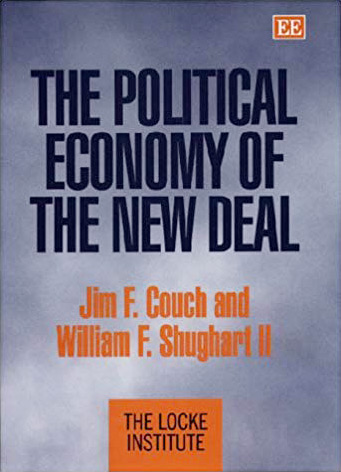 The Political Economy of the New Deal, by Jim F. Counch and William F. Shughart II. Locke Institute, 1998.
The Political Economy of the New Deal, by Jim F. Counch and William F. Shughart II. Locke Institute, 1998.
The authors conclude “that weight of this evidence . . . points to a political explanation for New Deal spending patterns: other things being the same, more federal aid was allocated to states which had supported FDR most solidly in 1932 and which were crucial to the president’s 1936 Electoral College strategy.” The New Dealers were manipulative Machiavellians, not selfless ministers to the needy.
“Poor Before Welfare,” by David T. Beito. National Review, May 6, 1996, pp. 42-43.
Beito argues that one can divide aid to the poverty-stricken into two categories: hierarchical and reciprocal. Hierarchical relief comes from the government or as charity from the recipients’ social superiors. In reciprocal relief, “donors and recipients tended to come from the same, or nearly the same, walks of life; today’s recipient could be tomorrow’s donor, and vice versa.” Reciprocal relief comes from lodges, fraternal associations, and mutual aid societies. Reciprocal aid avoids the shame and stigma of dependency and the creation of a permanent pauper class. Such reciprocal aid was pervasive in the United States before the coming of the welfare state and its easy and sticky dependency.
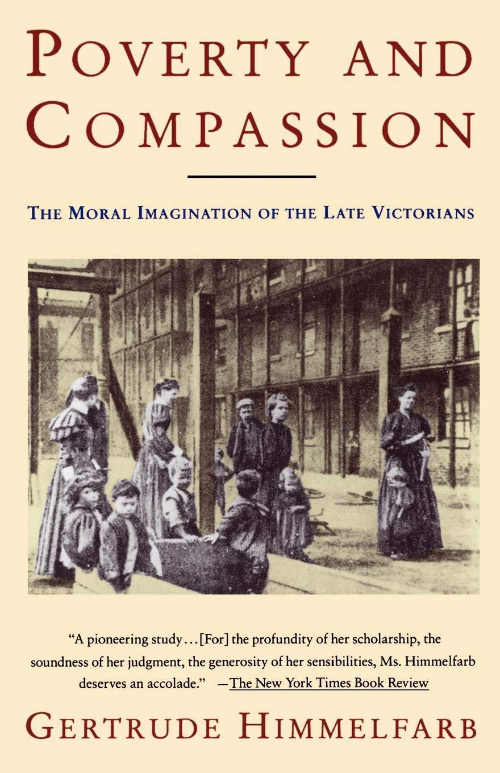 Poverty and Compassion: The Moral Imagination of the Late Victorians, by Gertrude Himmelfarb. Vintage, 1992.
Poverty and Compassion: The Moral Imagination of the Late Victorians, by Gertrude Himmelfarb. Vintage, 1992.
Himmelfarb writes, among other things, about the distinction the Victorians made between the paupers (the dependent and the unrespectable poor) and the “working classes,” who were viewed as “respectable, deserving, worthy, endowed with the puritan virtues that had served the middle classes so well.” David Brooks writes, “Himmelfarb argued that the Victorians who started the Salvation Army, the various aid societies, and the settlement-house movement worked hard to serve the poor in a disciplined, realistic, sacrificial way, not in a self-indulgent way that would make them feel good but do nothing for those in need.
 Poverty: Definition and Perspective, by Rose D. Friedman. AEI Press, 1965. Download PDF
Poverty: Definition and Perspective, by Rose D. Friedman. AEI Press, 1965. Download PDF
A review of the criteria used to determine poverty accompanied by clarifying remarks about measures of relative poverty. Friedman notes, “Many individuals, private organizations, and governmental bodies have been and are continuously engaged in widespread activity to cope with the problems of low income groups. This activity has, if anything, grown over the decades despite major improvements in the material welfare of the most disadvantaged groups in the community.”
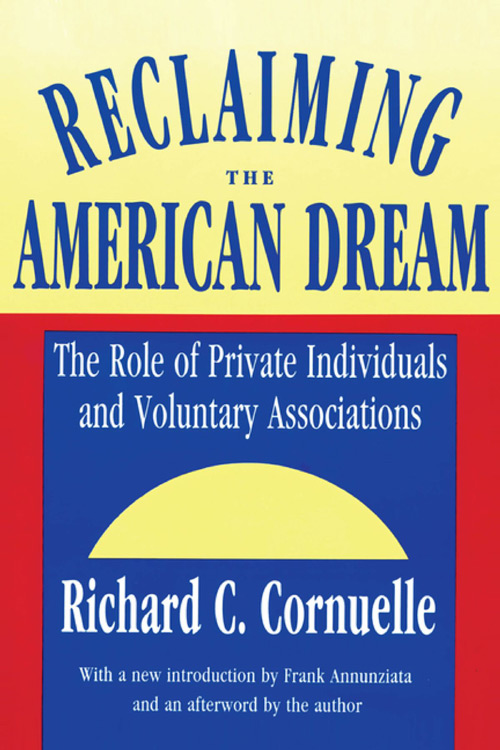 Reclaiming the American Dream, by Richard Cornuelle. Routledge, 1993.
Reclaiming the American Dream, by Richard Cornuelle. Routledge, 1993.
Frank Aunnziata’s foreword reads, “[Historian of American philanthropy] Robert Bremner . . . described Cornuelle’s work as ‘the starting point for both casual readers and academic scholars,’ [and] ‘rendered its thesis as advocating “reliance on voluntary organizations rather than ‘unlimited government’” as [the] best solution to social problems.’”
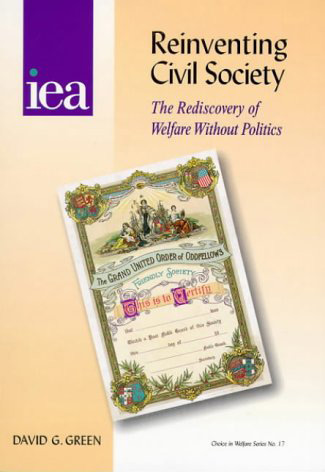 Reinventing Civil Society: The Rediscovery of Welfare Without Politics, by David G. Green. Institute of Economic Affairs Health and Welfare Unit, 1993.
Reinventing Civil Society: The Rediscovery of Welfare Without Politics, by David G. Green. Institute of Economic Affairs Health and Welfare Unit, 1993.
Green shows how voluntary institutions can substitute for public programs of poverty alleviation and how they have done so in the past.
“Thy Brother’s Keeper: The Mutual Aid Tradition of American Fraternal Orders,” by David T. Beito. Policy Review, no. 70 (Fall 1994), pp. 55–60.
Beito provides a deep history of early American fraternal groups. Differing in type and in membership perks, these societies successfully offered mutual aid prior to the inception of the welfare state and also doubled as an important center of community. Beito writes, “The fraternal orders’ memberships were not as broad-based or large as the secret societies, and generally were centered around a particular occupation, but shared with secret societies a system of lodge organization, a democratic form of internal government, ritual, and mutual aid for members and their families, ... while insurance coverage was a key benefit of fraternal society membership. Insurance coverage was still rare in the 19th century; many Americans with any type of insurance were covered through their affiliation with a fraternal organization. The insurance provided by these groups was invariably some form of death benefit. These payments began as small sums, often just enough to pay for a funeral. As membership spread and the actuarial base grew, benefits increased as well, but were always viewed as a supplement to other means of support—a way to help the family get back on its feet after the death of the bread-winner.”
 To Empower People: The Role of Mediating Institutions in Public Policy, by Peter Berger and Richard John Neuhaus. American Enterprise Institute, Second Edition, 1996.
To Empower People: The Role of Mediating Institutions in Public Policy, by Peter Berger and Richard John Neuhaus. American Enterprise Institute, Second Edition, 1996.
The American Enterprise Institute synopsis reads, “In 1977, AEI published a now-famous essay by Peter L. Berger and Richard John Neuhaus that examined the crucial importance of such ‘mediating structures’ as family, church, and neighborhood to a healthy civil society. This new edition contains the original text of that essay, eleven new essays by distinguished social scientists that assess what has happened since, and a response by the original authors to the new essays.”
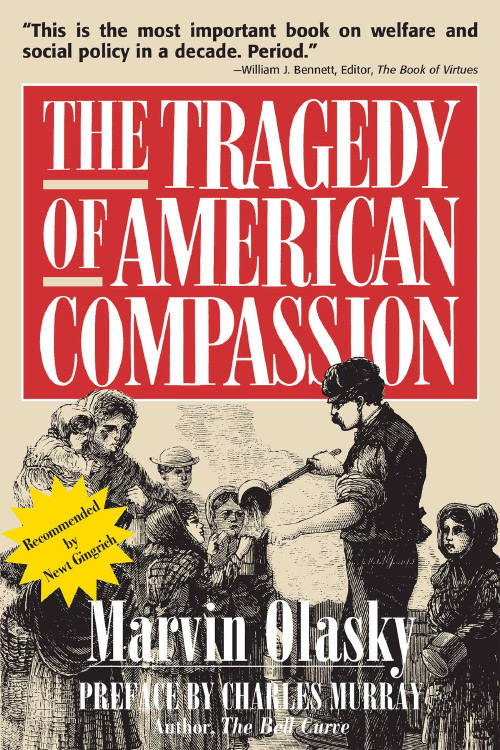 The Tragedy of American Compassion, by Marvin Olasky. Regnery Publishing, 1994.
The Tragedy of American Compassion, by Marvin Olasky. Regnery Publishing, 1994.
An accessible history of private charity in the United States, its success and eventual decline. Olasky’s work is notable for its coverage of poverty-fighting efforts prior to the New Deal. Daniel Bazikian’s review reads, “[The] absence [of] contemporary charity does so much to explain the spiritual and moral poverty of American compassion and its tragic social consequences: the decline in upward mobility of the poor; the weakened state of private charity; and the disintegrating state of marriage. These principles, Olasky contends, need to be re-inserted and reintegrated into programs to aid the poor.”
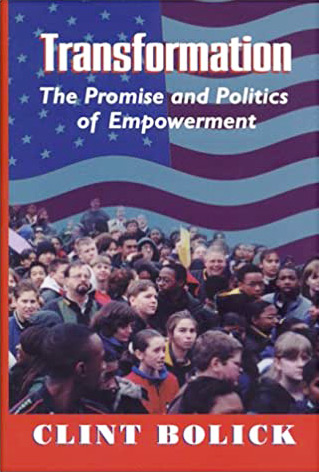 Transformation: The Promise and Politics of Empowerment, by Clint Bolick. Institute for Contemporary Studies, 1998.
Transformation: The Promise and Politics of Empowerment, by Clint Bolick. Institute for Contemporary Studies, 1998.
Bolick writes, “[W]henever meaningful reform is proposed to give low-income people greater power over their lives, reactionary special interest groups—labor unions, government bureaucrats, and too often their allies in the civil rights establishment—can be counted on to mount tenacious opposition in the legislatures, courts, and media to preserve the status quo. . . . [Yet] increasingly, the more tangible benefits for the poor are seen in policies that reduce government dependence rather than those that foster it.”
Voluntary Organizations and the Welfare State, by Robert Sugden. In Privatisation and the Welfare State, edited by Julian Le Grand and Ray Robinson, Allen & Unwin, 1984.
An exploration of privatizing the public welfare state and how the voluntary sector possesses unique merits relative to state welfare.
Wealth, Poverty, and Politics, by Gordon Tullock. Basil Blackwell, 1988.
Gordon L. Brady’s review reads, “The themes of Wealth, Poverty, and Politics are why does the majority transfer income to non-majority elements (those with less than 50 percent of the vote) and why are government institutions inefficient. His vehicle for this examination is the nature of the voting process. He argues the institutional structure lies at the root of the problem that government income transfers go not to the poor, but to the well-organized including the bureaucracy that delivers the service.”
“A Welfare System That Works,” by Naomi Schaefer Riley. Philanthropy (Fall 2012).
Riley shows how the Church of Jesus Christ of Latter-day Saints operates a successful voluntary welfare system. She writes, “That spirit of generosity funds a vast private welfare system, one that serves hundreds of thousands of people each year. This welfare system serves mostly—but not exclusively—fellow Latter-day Saints who are in need. It is intended for people who have lost their jobs, who have been injured, or whose families are going through some other kind of hardship. Self-sufficiency is at the heart of its mission—both for the givers and receivers.”
 Welfare: The Political Economy of Welfare Reform in the United States, by Martin Anderson. Hoover Institution Press, 1978.
Welfare: The Political Economy of Welfare Reform in the United States, by Martin Anderson. Hoover Institution Press, 1978.
A view of the War on Poverty and the tall task of welfare reform from a former policy advisor to five presidential administrations. Includes extensive discussion of universal basic income and its precursor, the Speenhamland system, in England and Wales at the end of the eighteenth century and during the early nineteenth century.
“Welfare Without the Welfare State,” by Yale Brozen. Paper delivered before the Mont Pelerin Society, Tokyo, Japan, September 9, 1966.
Brozen writes, “With less attempt to use state power to compress the inequality in the distribution of income, inequality would diminish more rapidly. Low wage rates would rise more rapidly with a higher rate of saving and capital formation, and inequality would diminish with the rise in income of wage earners.”
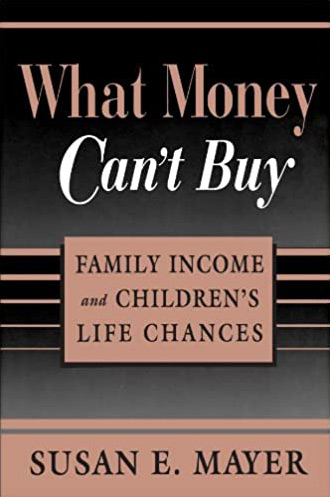 What Money Can’t Buy: Family Income and Children’s Life Chances, by Susan E. Mayer. Harvard University Press, 1998.
What Money Can’t Buy: Family Income and Children’s Life Chances, by Susan E. Mayer. Harvard University Press, 1998.
The Economist magazine writes, “[Susan Mayer] developed a statistical model that predicted what would happen to children’s prospects if poor families’ incomes were increased from $15,000 to $30,000 a year. The surprising answer is: not much. Ms Mayer found that although doubling the income of poor families would lift most children above the poverty line, it would have virtually no effect on their test scores and only a slight effect on social behaviour...There are two reasons for this. First, Ms Mayer notes that the extra money tends to be spent on such things as restaurant meals, clothes, dishwashers, roomier houses or second cars, none of which matters much in helping children succeed in school or life.... Second, good parenting has much in common with being a good worker. In both roles, the reward goes to diligence, determination, good health, willingness to co-operate, and so on. Children with parents who possess these qualities tend to do well in life, even if mother and father do not make much money.”
 Who Killed Civil Society? The Rise of Big Government and Decline of Bourgeois Norms, by Howard A. Husock. Encounter Books, 2019.
Who Killed Civil Society? The Rise of Big Government and Decline of Bourgeois Norms, by Howard A. Husock. Encounter Books, 2019.
How the government fails to properly advance social norms and why such a goal is best left to civil society, not government. Peter Schuck writes, “Howard Husock’s new book exhumes the bourgeois norms of personal and social uplift that preceding generations championed but that our current bureaucratic systems stifle and even discredit. By portraying the institutions these civil society pioneers built, and by spotlighting some of their successors’ work today, Husock argues that recovering and selling these norms―‘preaching what we practice,’ in Charles Murray’s apt phrase―is necessary for sustained progress for our most disadvantaged Americans and thus for the quality of our community life. I think he’s right.”
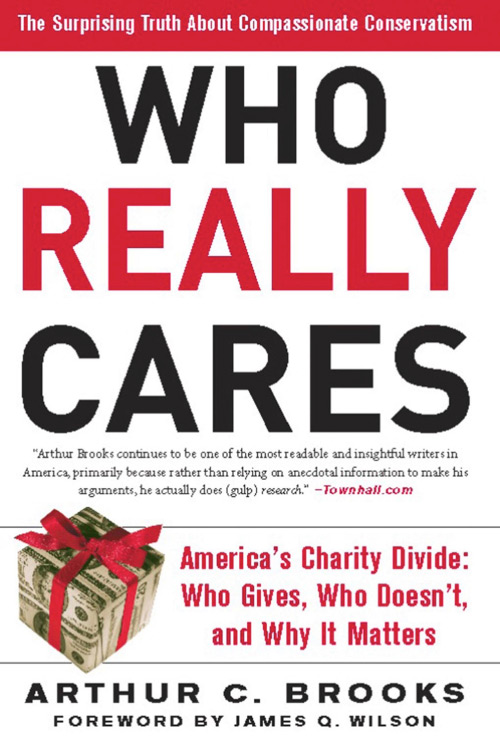 Who Really Cares: America’s Charity Divide: Who Gives, Who Doesn’t and Why It Matters, by Arthur C. Brooks. Basic Books, 2007.
Who Really Cares: America’s Charity Divide: Who Gives, Who Doesn’t and Why It Matters, by Arthur C. Brooks. Basic Books, 2007.
A look into the patterns of philanthropic endeavors culminating in the conclusion that giving is invaluable for economic prosperity and a healthy society. Brooks’s study is notable not only for its scope, but also for demonstrating the strong tradition of charity within conservatism. James Q. Wilson’s review reads, “Who Really Cares is not just about how we contribute time and money; it is also about how our culture may affect our politics and our economy. It is the best study of charity that I have read.”
“Work, Not Welfare: The Mormon Church Has Been Running Such a System for Decades,” by Ralph Hardy. The American Enterprise (September/October 1995), pp. 31–32.
A look at the private welfare program of the Church of Jesus Christ of Latter-Day Saints, which provides assistance and work programs for its members. As Hardy puts it, “The aim of the church is to help the people to help themselves.”
Working-Class Patients and the Medical Establishment: Self-Help in Britain from the Mid-Nineteenth Century to 1948, by David G. Green. St. Martin’s Press, 1985.
How the lower working class in Britain developed a private health care system on their own, only to inevitably be undermined by a government purporting to help them.








